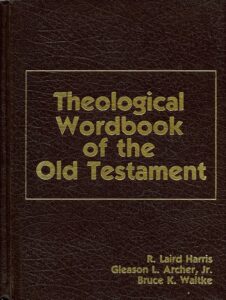Aug
4
Origins or Functions?: Contra the Walton Forms of Bara and Asa
This is the fifth & final entry in my series citing Rescuing Inerrancy: A Scientific Defense (2023) by Dr. Hugh Ross.

If you have read any of the earlier entries in this series, you might remember Dr. John Walton being mentioned as one of the modern Christian theologians making controversial claims regarding the Bible and Christianity, their relationships with history and science and ancient Near Eastern (ANE) literature, and related doctrines (e.g., inerrancy, dual revelation, concordism).
One of Walton’s contentions is that the Hebrew words normally translated as “create” and “make” should not be translated as such, because (he claims) ANE peoples surrounding Israel were virtually all about how things function and not on their material nature or origin. Thus, references in Genesis 1 to creating and forming the universe, Earth, light, land, water, animals, humans, etc., are actually about “unveiling the function of all things in the context of ‘the cosmos as a temple.'”
The citation below is the bulk of the Appendix in which Ross deals with Walton’s odd linguistic choices…
— — —
In the Journal for the Study of the Old Testament, Ellen van Wolde writes, “The linguistic and textual examination of the seven usages of the verb bara in Genesis 1 leads to the conclusion that the verb bara in Genesis 1 does not mean ‘to create’ but ‘to separate,'” in the spatial sense. She builds her case on the fact that bara in Genesis 1 applies to more than one element of creation at a time. In Genesis 1:1, bara is associated with the “heavens” and the “earth”; in 1:21, with the “birds” and “great sea creatures”; and in 1:27, with humans, “male” and “female.” On this basis, it could be used to distinguish, or “separate,” each of the two things from the other.
The first problem with this conclusion comes from the recognition that “the heavens and the earth” in Genesis 1:1 is not a reference to two separate things. Rather, it is a merism, a phrase used to express completeness. Some common examples [in English] are loving someone “heart and soul” or searching “high and low.” In Hebrew, this particular merism is used with reference to the entirety of the physical realm of which Earth is a part. Biblical Hebrew has no single word that means “the universe.” Therefore, it uses a distinct phrase, in this case “the heavens and the earth,” to take on that definition.
A second problem is that Genesis 1 does not read like an account about separation. God did not spatially separate mankind in his own image or spatially separate human males from human females.

Although the Theological Wordbook of the Old Testament states that bara in the Qal verb form means “create” or “make,” it also allows for a slightly different meaning in the Piel verb form: “choose,” “cut down,” or “dispatch.” However, in Genesis 1, bara appears only in the Qal form, not in the Piel form.
In his book The Lost World of Genesis 1, John Walton asserts that “Genesis 1 was never intended to offer an account of material origins” and therefore “offers no descriptive mechanism for material origins.” Walton views Genesis 1 as “an account of functional origins,” and on this basis, he claims that “bara is not a material activity but a functional one.”
Rather than to say the Hebrew-English lexicons over the past millennium were wrong in their definitions of bara and asa, Walton suggests that the lexicographers failed to take notice of other components of what bara and asa can mean. In his words, “It [the functional definition] is simply one they have never considered because their material ontology was a blind presupposition for which no alternative was ever considered.” He goes on to say that his alternative definition of bara is fitting because “no materials for the creative act are ever mentioned.”
In Genesis 1, the verb bara is used for the creation of “the heavens and the earth.” Given that the universe is, indeed, a material entity, Walton’s claim in contradicted in the very first verse.
Where God is acting, bara means to create something new and unparalleled that did not exist before. Asa means to manufacture or fashion something out of previously existing resources. Thus, the only instance in Genesis 1 where bara refers to something physical is in Genesis 1:1, where God creates physical matter and energy. It would be inappropriate to use bara for anything physical thereafter. This interpretation fits with Hebrews 11:3, which says, “By faith we understand that the universe was formed at God’s command, so that what is seen was not made out of what was visible.”
The second of the three uses of bara in Genesis 1 denotes God’s creation of nephesh, the “soulish” birds and sea mammals. The third use refers to creation of the humans, the “spiritual” creatures bearing his image. Creative acts 2 and 3 are simultaneously material and nonmaterial. The creatures in each case have material bodies, but they also have a new and immaterial quality that did not previously exist.
It makes sense, then, that the writer would limit his use of bara to only these three creative acts while using the verb asa with reference to other acts of creation. From the context alone, it appears that bara in this passage refers to creation of something new and unparalleled that did not previously exist.

The verb bara in the Qal form occurs 48 times in the Old Testament. In every instance, God is the subject or implied subject of the verb. In all 48 appearances, bara is in the masculine singular form. The masculine pronoun ‘he’ is implied, a peculiarity of this verb used only of God. This exclusivity indicates that bara refers to divine activity, beyond what humans are capable of performing. Given that humans can and do assign functions to many material entities, it seems problematic to claim that in Genesis 1, bara refers only to the assignment of function.
Concerning asa, Walton claims that in Genesis 1 it always means doing and never means making. Such a claim makes for awkward translations of Genesis 1:16, 25, and 26 as “God did two great lights and also did the stars,” “God did the wildlife of the earth,” and “let us do mankind in our image,” respectively. Such translations are not only bizarre but also inconsistent with the other Old Testament creation passages….
Finally, if there were any validity to Walton’s definitions, one would expect to find support for them in one or more of the several Hebrew-English lexicons. Given that God desires to speak to all generations of humanity through the Bible, to assert that all the lexicons throughout church history have been wrong about the meanings of both of these verbs seems unreasonable.
— — —
Just to clarify something in that last paragraph, I believe “all generations of humanity through the Bible” can be read there as “all post-Exodus generations of humanity through God’s Word preserved in the Judeo-Christian Scriptures.” Ross’s phrasing is more concise, of course, but I was afraid it might cause a red flag or two among more careful, detail-oriented readers.
I was already familiar with the basics of Walton’s approach but haven’t read any of his books nor any well-thought out critiques. So, I was very happy to see that Ross added this material in an appendix to Rescuing Inerrancy. There may be a response by Walton or his followers, and there may be an even more comprehensive critique responding to other points. But, I’ll wager that Ross has addressed the major points here and provided the rest of us with some darn good arguments against Walton’s view.















